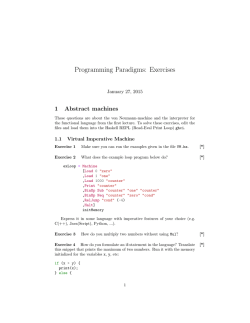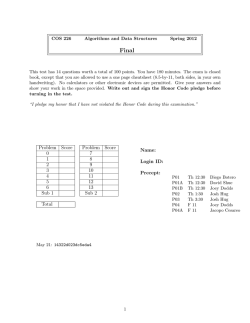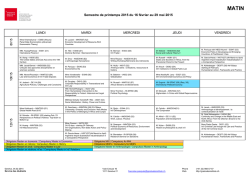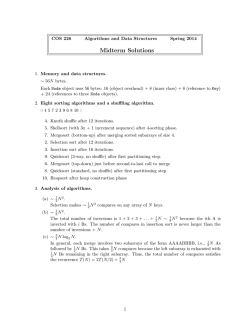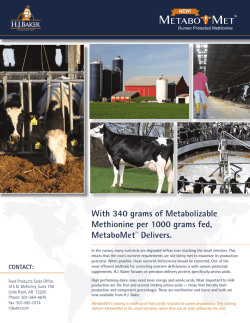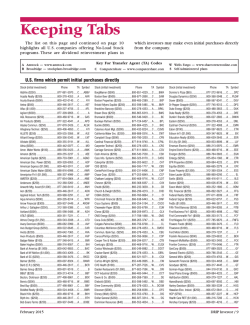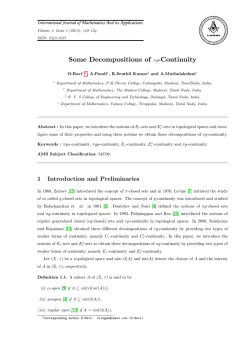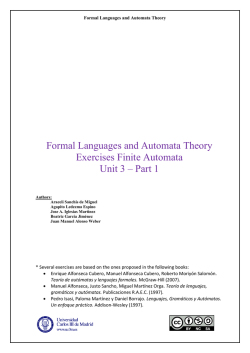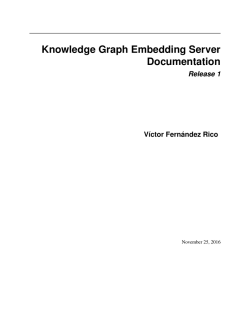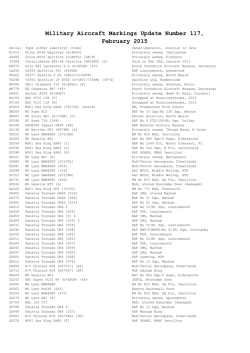
Final Exam - Princeton University
COS 226
Algorithms and Data Structures
Spring 2014
Final Exam
This test has 15 questions worth a total of 100 points. You have 180 minutes. The exam is closed
book, except that you are allowed to use a one page cheatsheet (8.5-by-11, both sides, in your own
handwriting). No calculators or other electronic devices are permitted. Give your answers and
show your work in the space provided. Write out and sign the Honor Code pledge before
turning in the test.
“I pledge my honor that I have not violated the Honor Code during this examination.”
Problem Score
0
1
2
3
4
5
6
7
Sub 1
Problem Score
8
9
10
11
12
13
14
Name:
netID:
Room:
Precept:
Sub 2
Total
1
P01
P02
P03
P04
P05
P05A
P06
P06A
P06B
P07
Th 11
Th 12:30
Th 1:30
F 10
F 11
F 11
F 2:30
F 2:30
F 2:30
F 3:30
Andy Guna
Andy Guna
Chris Eubank
Jenny Guo
Madhu Jayakumar
Nevin Li
Josh Hug
Chris Eubank
Ruth Dannenfelser
Josh Hug
2
PRINCETON UNIVERSITY
0. Initialization. (1 point)
In the space provided on the front of the exam, write your name and Princeton netID; circle
your precept number; write the name of the room in which you are taking the exam; and
write and sign the honor code.
1. Analysis of algorithms. (8 points)
(a) You observe the following running times for a program with an input of size N .
N
time
1,000
0.1 seconds
2,000
0.3 seconds
4,000
2.5 seconds
8,000
19.8 seconds
16,000
160.1 seconds
Estimate the running time of the program (in seconds) on an input of size N = 80, 000.
seconds
(b) Consider the following implementation of a binary trie data type:
public class BinaryTrieST<Value> {
private Node root;
// root of trie
private int N;
// number of nodes in the trie
private class Node {
private Value val;
private Node left;
private Node right;
}
...
}
Using the 64-bit memory cost model from lecture and the textbook, how much memory
(in bytes) does a BinaryTrieST object use to store M key-value pairs in N nodes?
Use tilde notation to simplify your answer. Do not include the memory for the values
themselves but do include all other memory (including pointers to values).
∼
bytes
COS 226 FINAL, SPRING 2014
3
(c) For each function on the left, give the best matching order of growth of the running time
on the right. You may use an answer more than once or not at all.
−− B−−
−−−−−
−−−−−
public static int f1(int N) {
int x = 0;
for (int i = 0; i < N; i++)
x++;
return x;
}
A. R
public static int f2(int N, int R) {
int x = 0;
for (int i = 0; i < R; i++)
x += f1(i);
return x;
}
D. N log R
public static int f3(int N, int R) {
int x = 0;
for (int i = 0; i < R; i++)
for (int j = 0; j < N; j++)
x += f1(j);
return x;
}
G. R2
B. N
C. N + R
E. R log N
F. N R
H. N 2
I. N R log N
J. N R log R
−−−−−
public static int f4(int N, int R) {
int x = 0;
for (int i = 0; i < N; i++)
for (int j = 1; j <= R; j += j)
x++;
return x;
}
K. N R2
L. RN 2
M. R3
−−−−−
public static int f5(int N, int R) {
int x = 0;
for (int i = 0; i < N; i++)
for (int j = 1; j <= R; j += j)
x += f1(j);
return x;
}
N. N 3
4
PRINCETON UNIVERSITY
Final, Spring 2014
2. Graph search. (6 points)
Consider the following digraph. Assume the adjacency lists are in sorted order: for example,
when iterating through the edges pointing from 2, consider the edge 2 → 3 before either
2 → 7 or 2 → 8.
0
1
2
3
4
5
6
7
8
9
postorder:
preorder:
Run depth-first search on the digraph, starting from vertex 0.
(a) List the vertices in reverse postorder.
0
___
___
___
___
___
___
___
___
___
___
___
___
___
___
___
___
___
(b) List the vertices in preorder.
0
___
___
___
COS 226 FINAL, SPRING 2014
5
Final, Spring 2014
3. Maximum flow. (10 points)
Consider the following flow network and feasible flow f from from the source vertex A to the
sink vertex J.
flow
A
1/6
F
B
20 / 20
5
/
4
G
1/1
C
8/8
8/8
12
capacity
/
11
4/9
14 / 14
H
4 / 10
D
6
5/5
0
/
9 / 14
0
I
22 / 24
/
17
17 / 17
augmenting path: A-G-B-H-C-D-E-J"
min cut: { A, B, F, G, H, I }
max flow value = 30
(a) What is the value of the flow f ?
(b) Starting from the flow f given above, perform one iteration of the Ford-Fulkerson algorithm. List the sequence of vertices on the augmenting path.
(c) What is the value of the maximum flow?
(d) Circle the vertices on the source side of a minimum cut.
A
B
C
D
E
F
G
H
I
J
(e) Give one edge such that if its capacity were decreased by one, then the value of the
maxflow would decrease.
E
9 / 15
J
6
PRINCETON UNIVERSITY
Final, Spring 2014
4. Shortest paths. (6 points)
Suppose that you are running Dijkstra’s algorithm on the edge-weighted digraph below, starting from some vertex s (not necessarily 0).
cost
0
35
1
16
2
27
3
17
4
3
12
19
5
38
9
28
32
10
5
9
6
4
7
40
8
5
9
shortest path: 5 0 6 7 3
The table below gives the edgeTo[] and distTo[] values immediately after vertex 7 has been
deleted from the priority queue and relaxed.
v
distTo[]
edgeTo[]
0
3.0
5→0
1
28.0
6→1
2
51.0
7→2
3
22.0
7→3
4
∞
null
5
0.0
null
6
9.0
5→6
7
13.0
6→7
8
53.0
7→8
9
∞
null
COS 226 FINAL, SPRING 2014
7
(a) Give the order in which the first 4 vertices were deleted from the priority queue and
relaxed.
7
(b) Which is the next vertex after 7 to be deleted from the priority queue and relaxed?
0
1
2
3
4
5
6
7
8
9
(c) In the table below, fill in those entries (and only those entries) in the edgeTo[] and
distTo[] arrays that change (from the corresponding entries on the facing page) immediately after the next vertex after 7 is deleted from the priority queue and relaxed.
v
0
1
2
3
4
5
6
7
8
9
distTo[]
edgeTo[]
8
PRINCETON UNIVERSITY
5. String sorting algorithms. (7 points)
The column on the left is the original input of 24 strings to be sorted; the column on the right
are the strings in sorted order; the other 7 columns are the contents at some intermediate
step during one of the 3 radix sorting algorithms listed below. Match up each column with
the corresponding sorting algorithm. You may use a number more than once.
mink
moth
crow
myna
swan
wolf
mule
slug
hare
bear
kiwi
calf
hawk
ibex
oryx
lion
sole
wasp
lynx
hoki
crab
deer
lamb
toad
---0
bear
calf
crow
crab
deer
hare
hawk
hoki
ibex
kiwi
lion
lynx
lamb
mink
moth
myna
mule
oryx
swan
slug
sole
toad
wolf
wasp
----
bear
calf
crow
crab
hare
kiwi
deer
hawk
ibex
hoki
lion
lynx
lamb
mink
mule
myna
moth
wasp
sole
oryx
slug
wolf
toad
swan
----
calf
lamb
hare
wasp
hawk
ibex
bear
deer
mink
lion
kiwi
slug
toad
hoki
sole
wolf
moth
crab
crow
oryx
mule
swan
myna
lynx
----
crow
lamb
deer
crab
hare
bear
kiwi
calf
hawk
ibex
hoki
lion
lynx
mink
mule
myna
moth
wasp
sole
oryx
slug
wolf
toad
swan
----
myna
crab
lamb
toad
mule
hare
sole
wolf
calf
slug
moth
kiwi
hoki
mink
hawk
swan
lion
wasp
bear
deer
crow
ibex
oryx
lynx
----
crab
toad
swan
bear
deer
ibex
hoki
mule
sole
wolf
calf
lamb
myna
mink
lynx
lion
crow
hare
wasp
moth
slug
kiwi
hawk
oryx
----
bear
crow
calf
crab
deer
hare
hawk
hoki
ibex
kiwi
lion
lynx
lamb
mink
moth
myna
mule
oryx
swan
slug
sole
toad
wolf
wasp
----
(0) Original input
(2) MSD radix sort
(1) LSD radix sort
(3) 3-way radix quicksort (no shuffle)
(4) Sorted
bear
calf
crab
crow
deer
hare
hawk
hoki
ibex
kiwi
lamb
lion
lynx
mink
moth
mule
myna
oryx
slug
sole
swan
toad
wasp
wolf
---4
COS 226 FINAL, SPRING 2014
9
6. Ternary search tries. (5 points)
Consider the following ternary search trie over the alphabet { A, C, G, T }, where the values
are shown next to the nodes of the corresponding string keys. The node containing ? contains
Spring 2014
one of the characters { A, C, G, TFinal,
}.
G
0
A
C
T
T
1
A
T
T
C
T
2
3
A
T
6
5
4
A
T
7
T
?
T
10
Circle which one or more of the following string keys are (or could be) in the TST above.
A
CT
GCA
GCG
GT
GTT
TA
TCA
TAT
TCT
TCTT
TGT
TTT
TTTT
T
8
G
9
10
PRINCETON UNIVERSITY
7. Knuth-Morris-Pratt substring search. (6 points)
Below is a partially-completed Knuth-Morris-Pratt DFA for a string s of length 10 over the
alphabet { A, B, C }.
0
1
2
3
4
5
6
7
8
9
A
4
5
2
B
0
0
7
3
C
0
0
0
10
s
Final, Spring 2014 KMP
(a) Reconstruct the string s in the last row of the table above.
(b) Complete the first row of the table above (corresponding to the character A).
0
1
2
3
4
5
Feel free to use this diagram for scratch work.
6
7
8
9
10
COS 226 FINAL, SPRING 2014
11
8. Boyer-Moore substring search. (6 points)
Suppose that you run the Boyer-Moore algorithm (the basic version considered in the textbook
and lecture) to search for the pattern
R O W S T H E
in the text
O C I E T Y E X C E P T T H E S C A R E C R O W S T H E
Final, Spring 2014
(a) Give the trace of the algorithm in the grid below, circling the characters in the pattern
that get compared with characters in the text.
O
C
I
E
T
Y
E
R
O
W
S
T
H
E
O
C
I
E
T
Y
E
R
O
W
S
T
H
E
R
X
C
E
P
T
T
H
E
S
C
A
R
E
C
R
O
W
S
T
H
E
X
C
E
P
T
T
H
E
S
C
A
R
E
C
R
O
W
S
T
H
E
O
W
S
T
H
E
H
E
R ofOlength
W S7 that
T would
H E result in the Y in the text being compared
(b) Give a pattern string
O W S algorithm.
T H E
twice when running theRBoyer-Moore
R
O
W
S
T
H
E
R
O
W
S
T
H
E
R
O
W
S
T
Final, Spring 2014
12
PRINCETON UNIVERSITY
9. Regular expressions. (7 points)
The following NFA is the result of applying the NFA construction algorithm from lecture and
the textbook to some regular expression.
ε-transition
0
1
2
3
4
5
6
7
8
9
10
11
(
A
*
|
(
A
B
*
A
)
*
)
(a) What is the regular expression?
(b) Suppose that you simulate the following sequence of characters on the NFA above:
A
A
A
A
A
A
A
In which one or more states could the NFA be?
0
1
2
3
4
5
6
7
8
9
10
11
12
(c) Suppose that you want to construct an NFA for the regular expression
( A * | ( A B * A ) + )
where the operator + means one or more copies. What minimal change(s) would you
make to the NFA above?
12
COS 226 FINAL, SPRING 2014
13
10. LZW compression. (5 points)
What is the result of expanding the following LZW-encoded sequence of 11 hexadecimal
integers?
43
41
42
42
82
43
81
41
87
82
80
Assume the original encoding table consists of all 7-bit ASCII characters and uses 8-bit
codewords. Recall that codeword 80 is reserved to signify end of file.
C
A
B
B
5.5
815
Data Compression
For reference, below is the hexademical-to-ASCII conversion table from the textbook:
g. When you HexDump a bit0 1 2 3 4 5 6 7 8 9 A B C D
ains ASCII-encoded charac- 0 NUL SOH STX ETX EOT ENQ ACK BEL BS HT LF VT FF CR
right is useful for reference. 1 DLE DC1 DC2 DC3 DC4 NAK SYN ETB CAN EM SUB ESC FS GS
it hex number, use the first 2 SP ! " # $ % & ‘ ( ) * + , w index and the second hex 3 0 1 2 3 4 5 6 7 8 9 : ; < =
n index to find the character 4 @ A B C D E F G H I J K L M
For example, 31 encodes the 5 P Q R S T U V W X Y Z [ \ ]
des the letter J, and so forth. 6 ` a b c d e f g h i j k l m
7-bit ASCII, so the first hex 7 p q r s t u v w x y z { | }
or less. Hex numbers starting
Hexadecimal-to-ASCII conversion table
nd the numbers 20 and 7F)
on-printing control charace control characters are left over from the days when physical devices
ers were controlled by ASCII input; the table highlights a few that you
E F
SO SI
RS US
. /
> ?
N O
^ _
n o
~
DEL
14
PRINCETON UNIVERSITY
11. Burrows-Wheeler transform. (8 points)
(a) What is the Burrows-Wheeler transform of the following?
B
D
A
B
A
C
A
C
Final, Spring 2014
Feel free to use this grid for scratch work.
(b) What is the Burrows-Wheeler inverse transform of the following?
4
D
A
D
C
C
C
D
B
Final, Spring 2014
Feel free to use this grid for scratch work.
COS 226 FINAL, SPRING 2014
15
12. Problem identification. (9 points)
You are applying for a job at a new software technology company. Your interviewer asks you
to identify which of the following tasks are possible, impossible, or unknown.
Given an undirected graph, determine if there exists a path of
length V − 1 with no repeated vertices in time proportional to
EV in the worst case.
A. Possible.
−−−−−
Given a digraph, determine if there exists a directed path between every pair of vertices in time proportional to E + V in
the worst case.
C. Unknown.
−−−−−
Given a digraph, design an algorithm to determine whether it
is a rooted DAG (i.e., a DAG in which there is a path from
every vertex to some root r) in time proportional to E + V in
the worst case.
−−−−−
Given a flow network (a digraph with positive edge capacities)
and two vertices s and t, find the the value of the min st-cut
in time proportional to E + V in the worst case.
−−−−−
Given a digraph where each edge is colored black or orange
and two vertices s and t, find a path from s to t that uses the
fewest number of black edges in time proportional to E + V in
the worst case.
−−−−−
Given an array a of N 64-bit integers, determine whether there
are two indices i and j such that ai = −aj in time proportional
to N in the worst case.
−−−−−
Given an array of N integers between 0 and R − 1, stably sort
them in time proportional to N + R in the worst case.
−−−−−
Determine how many times a pattern string of length M appears as a substring in a text string of length N in time proportional to M + N in the worst case. For simplicity, assume
the binary alphabet.
−−−−−
Design an algorithm that compresses at least half of all 10,000bit messages by one (or more) bits.
−−−−−
B. Impossible.
16
PRINCETON UNIVERSITY
13. Reductions. (8 points)
Consider the following two string-processing problems:
• Suffix-Array. Given a string s, compute its suffix array sa[].
• Circular-Suffix-Array. Given a string s, compute its circular suffix array csa[].
For example, the suffix array sa[] and circular suffix array csa[] of the string s = ABAAB are
given below, along with the the corresponding suffixes and circular suffixes (in parentheses).
i
0
1
2
3
4
s[i]
A
B
A
A
B
sa[i]
2 (AAB)
3 (AB)
0 (ABAAB)
4 (B)
1 (BAAB)
csa[i]
2 (AABAB)
0 (ABAAB)
3 (ABABA)
1 (BAABA)
4 (BABAA)
Show that Suffix-Array over the binary alphabet linear-time reduces to CircularSuffix-Array over the binary alphabet by completing parts (a) and (b).
(a) Show that Suffix-Array over the binary alphabet {A, B} linear-time reduces to
Circular-Suffix-Array over the base-4 alphabet {0, 1, 2, 3}.
i. Given a string input s to Suffix-Array over the alphabet {A, B}, how do
you construct the corresponding string input s to Circular-Suffix-Array
over the alphabet {0, 1, 2, 3}?
ii. Given the string input s = ABAAB, what is the corresponding string input s ?
You need not use all of the boxes.
iii. Given the solution csa[] to s , how do you construct the solution sa[] to s?
COS 226 FINAL, SPRING 2014
17
(b) Show that Circular-Suffix-Array over the base-4 alphabet {0, 1, 2, 3} lineartime reduces to Circular-Suffix-Array over the binary alphabet {A, B}.
i. Given a string input s to Circular-Suffix-Array over the alphabet {0, 1, 2, 3},
how do you construct the corresponding string input s to Circular-SuffixArray over the alphabet {A, B}?
ii. Given the string input s = 03122, what is the corresponding string input s ?
You need not use all of the boxes.
iii. Given the solution csa'[] to s , how do you construct the solution csa[] to
s?
14. Algorithm design. (8 points)
There are N dorm rooms, each of which needs a secure internet connection. It costs
wi > 0 dollars to install a secure router in dorm room i and it costs cij > 0 dollars to
Spring
2014
build a secure fiber connection between
rooms
i and j. A dorm room receives a secure
internet connection if either there is a router installed there or there is some path of
fiber connections between the dorm room and a dorm room with an installed router.
The goal is to determine in which dorm rooms to install the secure routers and which
pairs of dorm rooms to connect with fiber so as to minimize the total cost.
60
10
20
0
45
75
4
40
router cost
1
50
55
15
3
25
30
5
5
fiber cost
65
45
70
6
35
This instance contains 6 dorm rooms and 10 possible connections. The optimal
solution installs a router in dorm rooms 1 and 4 (for a cost of 10 + 40) and builds
the following fiber connections: 0-1, 1-6, 3-4, 4-5 (for a cost of 20 + 15 + 25 + 5).
Formulate the problem as a minimum spanning tree problem. To demonstrate your
formulation, modify the figure above to show the MST problem that you would solve
to find the minimum cost set of routers and fiber connections.
18
© Copyright 2026
